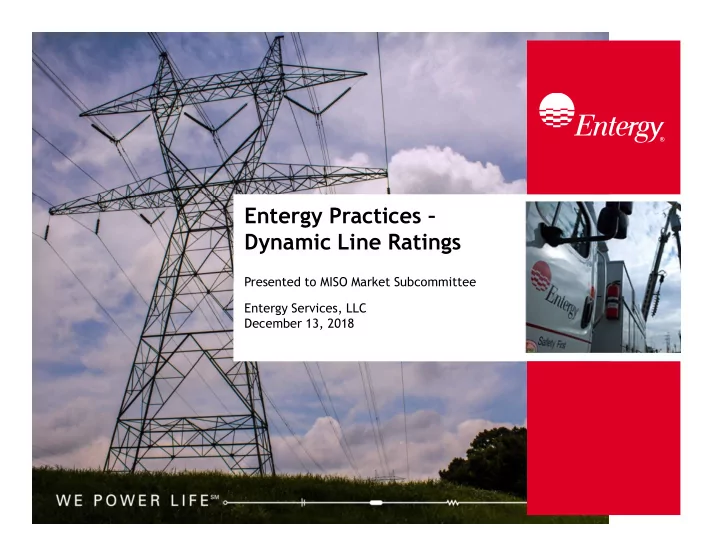

Click to edit Master title style Entergy Practices – Dynamic Line Ratings Presented to MISO Market Subcommittee Entergy Services, LLC December 13, 2018
1 Terminology Terminology Static and Dynamic line ratings Static Line Ratings are established using a set criteria based on conservative weather assumptions such as the one hour peak expected for the year or season. Typical assumptions for summer peaking systems are 40 o C ambient temperature, 2 feet per second wind speed perpendicular to the line and high solar radiation. Dynamic Line Ratings use technology to provide real time feedback of the environmental conditions near the line such as the value of ambient temperature, solar radiation and wind speed and direction. Dynamic Line Ratings can also provide data on transmission line clearances by measuring the conductor sag and real time current.
2 Entergy’s Use of Dynamic Line Ratings Entergy’s Use of Dynamic Line Ratings Temperature Adjusted Ratings Temperature Adjusted Ratings or Seasonal Adjusted Ratings take into account weather conditions that may differ throughout the year or season and can help increase the current carrying capability of the Static Line Ratings. By trending historical weather within Entergy’s footprint, Entergy has found that rating adjustments based upon ambient temperature deviations from peak periods provide the most efficient gains and are most predictable on a forward looking basis Entergy has adopted the use of Temperature Adjusted Ratings to gain more efficiency during off peak periods. Entergy provides hourly, daily and 2 day ahead temperature adjusted ratings for use in real time operations and in the MISO markets. There can be a large swing in ambient temperatures in the Entergy region regardless of season. As a result, Entergy does not use seasonal ratings but instead uses the more granular temperature adjusted ratings described above.
3 Entergy’s Use of Dynamic Line Ratings Entergy’s Use of Dynamic Line Ratings Short-Term Emergency Ratings Short-term Emergency Ratings allow for the operation of a given transmission facility for a short period of time at a level that exceeds the continuous rating of the facility. Working with MISO and the IMM, Entergy has identified certain congested facilities for which the use of short-term emergency ratings can be expected to deliver the most significant congestion- relief benefits and resulting savings to the MISO markets. Use of short-term emergency ratings carries a higher degree of risk due to the potential to degrade the applicable transmission facility or reduce its operating life. Consequently, in coordination with MISO and the IMM, Entergy uses short-term emergency ratings on a much more limited basis, on facilities from which the use of such ratings is expected to deliver maximum value to the MISO markets. Use of these ratings on a very limited basis also allows for the careful monitoring that is needed to ensure that the operational life and capabilities of the applicable facility are maintained.
4 Dynamic Line Ratings – Current Status Dynamic Line Ratings – Current Status • There are over 2,300 Entergy transmission facilities (69 kV or above) in the Operational Planning model • There are 978 Entergy transmission facilities in the TAR database • There are 140 Entergy transmission facilities in which a short term emergency rating is being supplied • Entergy is showing an average increase over the Base Facilities ratings of 11% when applying a Temperature Adjusted Rating • Entergy is showing an average increase over the Temperature Adjusted ratings of 13% when applying a Short Term Emergency Rating. TAR TAR EMG EMG Line / Auto* % Avg % MAX % Avg % MAX Rating Rating Rating Rating 69kV Line 21% 33% 0% 0% 115kV Line 12% 25% 10% 12% 138kV Line 11% 24% 16% 18% 161kV Line 12% 24% 10% 11% 230kV Line 11% 24% 10% 15% 500kV Line 12% 18% 14% 14% 138kV Auto 0% 0% 29% 29% 161kV Auto 0% 0% 28% 29% 230kV Auto 5% 5% 22% 22% 345kV Auto 4% 5% 21% 24% * Autotransformers cannot be temperature adjusted, 500kV Auto 1% 1% 19% 20% but the facilities connected to them can be. Average 11% 24% 13% 15% • Any adjustment to a tie line would include appropriate coordination between MISO and the affected Transmission Owner.
5 Entergy’s Line Ratings Entergy’s Line Ratings Current Rating Practice Entergy sets ratings for the following transmission facilities, which satisfy NERC Reliability Standards, specifically NERC Reliability Standard FAC-008: • Transmission line conductors including jumpers, and support hardware • Substation terminal equipment, including switches, circuit breakers, instrument transformers, buswork, fuses and line traps • Power and Auto-transformers • Relay protective devices • Series and shunt capacitors • Static VAR compensators Entergy’s Static Line Rating Methodology
6 MISO MISO Coordination with MISO Entergy works with MISO and the IMM to identify facilities for which the use of dynamic line ratings may provide benefits – whether in real time operations or to the MISO market. For facilities on which dynamic line ratings are used, Entergy provides dynamic ratings to MISO on an hourly, daily, and 2-day ahead basis. MISO Long-Term Planning Because the conditions that allow for the use of dynamic line ratings are not readily predictable on a long-term basis, dynamic line ratings are more useful in operations and day-ahead/real-time markets than in long-term planning. In reliability planning, Entergy uses emergency ratings for its facilities, consistent with NERC Planning Standards. This emergency rating used for this purpose differs from the Dynamic Line Ratings used in operations and discussed on previous slides. In economic planning, the PROMOD model that MISO uses does not assume the use of dynamic line ratings on any facilities, although such ratings are used by some transmission owners in operations.
7 Questions? Questions?
Recommend
More recommend